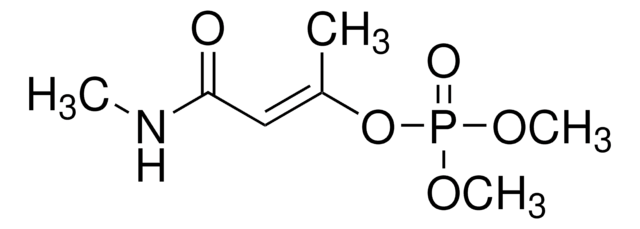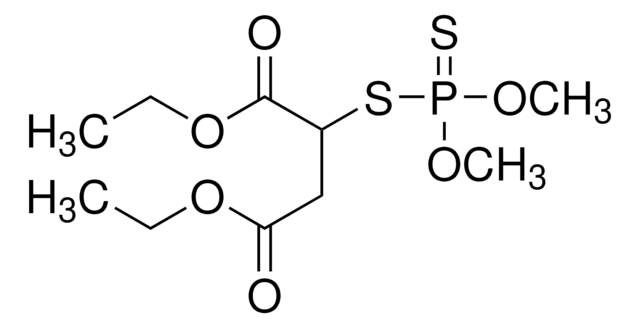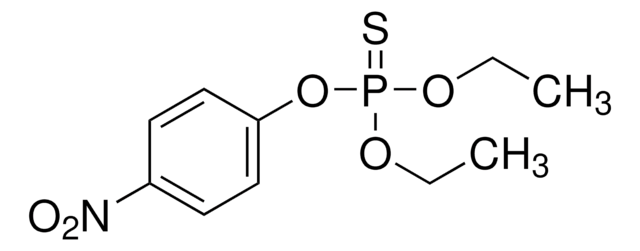43648
Parathion-methyl
certified reference material, TraceCERT®
Synonyme(s) :
Méthylparathion
About This Item
Produits recommandés
Qualité
certified reference material
TraceCERT®
Niveau de qualité
Gamme de produits
TraceCERT®
Durée de conservation
limited shelf life, expiry date on the label
Format
neat
Température de stockage
2-8°C
Chaîne SMILES
COP(=S)(OC)Oc1ccc(cc1)[N+]([O-])=O
InChI
1S/C8H10NO5PS/c1-12-15(16,13-2)14-8-5-3-7(4-6-8)9(10)11/h3-6H,1-2H3
Clé InChI
RLBIQVVOMOPOHC-UHFFFAOYSA-N
Vous recherchez des produits similaires ? Visite Guide de comparaison des produits
Description générale
Certified content by quantitative NMR incl. uncertainty and expiry date are given on the certificate.
Download your certificate at: http://www.sigma-aldrich.com.
Parathion methyl is a non-systemic organophosphate insecticide and acaricide. It acts by inhibiting the activity of the acetylcholinesterase (AChE) enzyme, thereby blocking hydrolysis of acetylcholine and leading to hyperexcitation. It is used to control chewing and sucking insects in cereals, fruit, citrus, vines, vegetables, ornamentals, cotton, and field crops.
According to the Commission Implementing Regulation (EU) No 2003/166/EC of 10th March 2003, parathion methyl is not approved for use in the European Union (EU) as a plant protection agent, following the Regulation (EC) No. 1107/2009. But maximum residue levels of 0.01 mg/kg to 5 mg/kg are allowed for the presence of parathion methyl (sum of parathion-methyl and paraoxon-methyl expressed as parathion-methyl) in products of plant and animal origin, according to the EU Reg. No 899/2012.
Parathion methyl has to be monitored in the Multiannual Control Programme for Pesticides Residues (MACP), run within the EU and EFTA in/on products of plant origin.
Application
Parathion methyl CRM may also be used as given below:
- Development of a fluorescence sensor based on near-infrared CuInS2 quantum dots (QDs) and organophosphorus hydrolase (OPH) to detect parathion methyl in tap water, river water, rice, and banana samples
- Evaluate polyaniline (PANI)-modified zeolite NaY as a sorbent for the extraction of multiclass pesticides from water, soil, honey, fruit, and vegetable samples and their quantification by high-performance liquid chromatography (HPLC) coupled with photodiode array (PDA) detection
- Determination of 36 pesticides in soil samples using modified QuEChERS method for extraction and dispersive-solid phase extraction (d-SPE) for clean-up, followed by quantification with liquid chromatography with tandem quadrupole linear ion trap mass spectrometry (LC-MS/MS)
- Multi-residue analysis of 160 multiclass pesticides using ethyl acetate (EtAC)/n. hexane mixture for extraction from chamomile, thyme, and marjoram samples and their analysis by gas chromatography-tandem mass spectrometry (GC-MS/MS)
- Optimization of a gas chromatography-flame photometry detector (GC-FPD) based method for the determination of 44 organophosphorous pesticide (OPP) residues in Pogostemon cablin and related product samples
- Simultaneous residue analysis of 379 pesticides in human serum samples using QuEChERS extraction method and liquid chromatography-tandem mass spectrometry (LC-MS/MS)
Informations légales
Vous ne trouvez pas le bon produit ?
Essayez notre Outil de sélection de produits.
Mention d'avertissement
Danger
Mentions de danger
Conseils de prudence
Classification des risques
Acute Tox. 2 Inhalation - Acute Tox. 2 Oral - Acute Tox. 3 Dermal - Aquatic Acute 1 - Aquatic Chronic 1 - Flam. Liq. 3 - STOT RE 2
Code de la classe de stockage
3 - Flammable liquids
Classe de danger pour l'eau (WGK)
WGK 3
Point d'éclair (°F)
114.8 °F - open cup
Point d'éclair (°C)
46 °C - open cup
Faites votre choix parmi les versions les plus récentes :
Certificats d'analyse (COA)
Vous ne trouvez pas la bonne version ?
Si vous avez besoin d'une version particulière, vous pouvez rechercher un certificat spécifique par le numéro de lot.
Déjà en possession de ce produit ?
Retrouvez la documentation relative aux produits que vous avez récemment achetés dans la Bibliothèque de documents.
Notre équipe de scientifiques dispose d'une expérience dans tous les secteurs de la recherche, notamment en sciences de la vie, science des matériaux, synthèse chimique, chromatographie, analyse et dans de nombreux autres domaines..
Contacter notre Service technique








